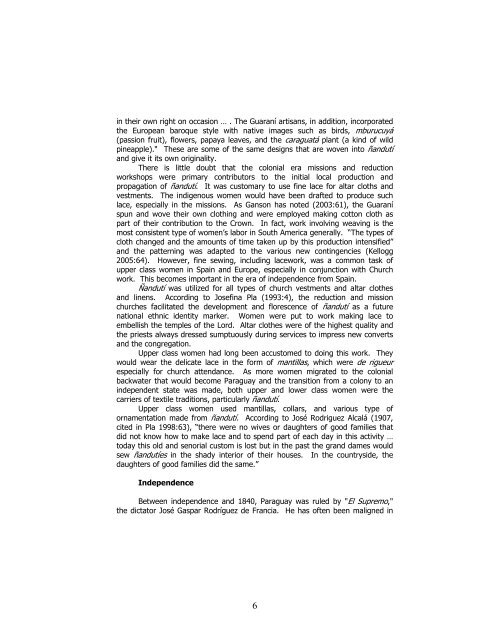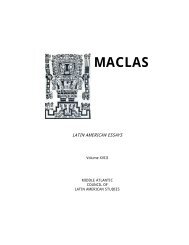latin american essays maclas
latin american essays maclas
latin american essays maclas
Create successful ePaper yourself
Turn your PDF publications into a flip-book with our unique Google optimized e-Paper software.
in their own right on occasion … . The Guaraní artisans, in addition, incorporated<br />
the European baroque style with native images such as birds, mburucuyá<br />
(passion fruit), flowers, papaya leaves, and the caraguatá plant (a kind of wild<br />
pineapple)." These are some of the same designs that are woven into ñandutí<br />
and give it its own originality.<br />
There is little doubt that the colonial era missions and reduction<br />
workshops were primary contributors to the initial local production and<br />
propagation of ñandutí. It was customary to use fine lace for altar cloths and<br />
vestments. The indigenous women would have been drafted to produce such<br />
lace, especially in the missions. As Ganson has noted (2003:61), the Guaraní<br />
spun and wove their own clothing and were employed making cotton cloth as<br />
part of their contribution to the Crown. In fact, work involving weaving is the<br />
most consistent type of women’s labor in South America generally. “The types of<br />
cloth changed and the amounts of time taken up by this production intensified”<br />
and the patterning was adapted to the various new contingencies (Kellogg<br />
2005:64). However, fine sewing, including lacework, was a common task of<br />
upper class women in Spain and Europe, especially in conjunction with Church<br />
work. This becomes important in the era of independence from Spain.<br />
Ñandutí was utilized for all types of church vestments and altar clothes<br />
and linens. According to Josefina Pla (1993:4), the reduction and mission<br />
churches facilitated the development and florescence of ñandutí as a future<br />
national ethnic identity marker. Women were put to work making lace to<br />
embellish the temples of the Lord. Altar clothes were of the highest quality and<br />
the priests always dressed sumptuously during services to impress new converts<br />
and the congregation.<br />
Upper class women had long been accustomed to doing this work. They<br />
would wear the delicate lace in the form of mantillas, which were de rigueur<br />
especially for church attendance. As more women migrated to the colonial<br />
backwater that would become Paraguay and the transition from a colony to an<br />
independent state was made, both upper and lower class women were the<br />
carriers of textile traditions, particularly ñandutí.<br />
Upper class women used mantillas, collars, and various type of<br />
ornamentation made from ñandutí. According to José Rodriguez Alcalá (1907,<br />
cited in Pla 1998:63), “there were no wives or daughters of good families that<br />
did not know how to make lace and to spend part of each day in this activity …<br />
today this old and senorial custom is lost but in the past the grand dames would<br />
sew ñandutíes in the shady interior of their houses. In the countryside, the<br />
daughters of good families did the same.”<br />
Independence<br />
Between independence and 1840, Paraguay was ruled by "El Supremo,"<br />
the dictator José Gaspar Rodríguez de Francia. He has often been maligned in<br />
6




